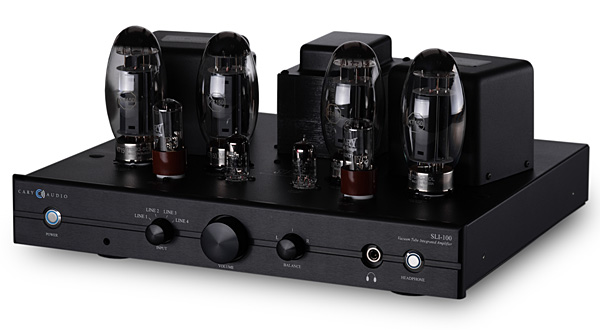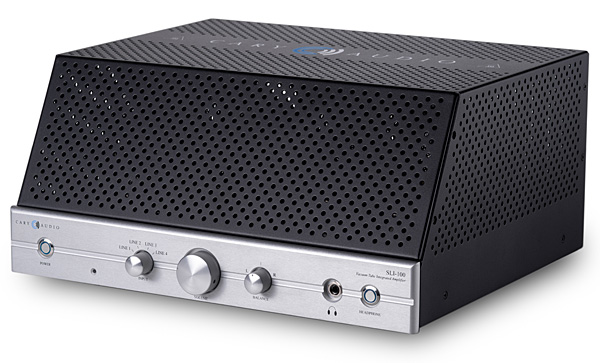| Columns Retired Columns & Blogs |
I'm waiting for a comparison follow-up review between Cary SLI-100 and Cambridge Edge A .......... The only thing common I can find between the two is, both company names start with the letter 'C' :-) ...........
Both amps drove my Harbeths with an attractive, refined clarity. Both amps could boogie. Both were equally nuanced. Both played symphonies, sonatas, and blues harmonicas in a natural, non–hi-fi manner. Neither sounded tubey or transistory.
But! Each amp presented in a strikingly different manner Sarasate's superseductive Carmen Fantasy, based on themes from Bizet's opera, as performed by violinist Anne-Sophie Mutter on the compilation Simply Anne-Sophie, accompanied by James Levine conducting the Vienna Philharmonic (16/44.1 FLAC, Deutsche Grammophon/Tidal). Mutter brings bounties of charisma, intelligence, and fierce vivacity to every performance, and through the Harbeth M30.2 and Cary SLI-100, the Carmen Fantasy did precisely what it's supposed to do: It seduced me, filling my imagination with Romani caravans, strong spirits, and exotic dancers. Mutter's distinctive touch extends the sonic effect of every note, drawing attention to its poetic purpose. The Cary seemed to enhance that quality.

I then played the first recording of the Sarasate I'd ever responded to, one I love and know well: by Ruggiero Ricci, with Pierino Gamba conducting the London Symphony Orchestra (16/44.1 FLAC, Decca/Tidal). This fantastic recording was first released in 1960, on one of the greatest LPs of all time: Decca SXL 2197. I've played it often on million-dollar hi-fis with some of the world's finest cartridges, but even via Tidal streaming, Ricci's violin tone remains the gold standard for tear-your-skin-off texture and supersaturated string tones. But after an hour of repeated plays, I realized that Ruggiero's Carmen Fantasy on Tidal into Schiit's Yggdrasil Analog 2 DAC feeding the Cary SLI-100 via Triode Wire Labs Spirit interconnects and driving the Harbeth Monitor M30.2s via Auditorium 23 speaker cables was not quite tearing my skin off. For that, I need the LP. But it did speak volumes about the quality of my Cary-Harbeth pairing, which delivered almost the full-intensity Decca midrange, plus the searing beautiful highs. The masterful subtleties of Ricci's playing were easy to discern and savor.
Fully intoxicated, I now craved master violinist Joseph Szigeti playing his buddy Béla Bartók's Romanian Folkdances, arranged by Zoltán Székely, with the composer at the piano (16/44.1 FLAC, Hungaroton/Tidal). The SLI-100 displayed Szigeti's extreme sweet/sour, dark/light lyricism in a manner I thought impossible without 300B or 211 triode tubes. Bartók's piano and Szigeti's violin were relatively close-miked in this recording from January 1930, but vividly present and musically intense. I thought I could hear inside Szigeti's violin.
Performances like these masterpieces by Mutter, Ricci, and Szigeti are why our world needs fine amplifiers—like the Rogue Stereo 100, the Pass Labs XA25, the Cary SLI-100—and loudspeakers they can drive. Via the Harbeth M30.2s, Mutter's art ascended highest with the Pass Labs XA25, Ricci's violin was its most skin-tearing with the Rogue Stereo 100 wired in Triode, and Szigeti playing Bartók produced more tear-jerking texture and presence when the Harbeths were powered by the Cary SLI-100.
Remember that SRPP 6DJ8 tube I told you about? Its linear, high-transconductance "sensitivity" is quite possibly the reason Szigeti's violin and Bartók's piano sounded so dense and microtextured.

With headphones
My favorite headphone amp is no headphone amp. I know it's illegal, but I like connecting headphones directly to the speaker binding posts on the backsides of power amplifiers. The resulting combination of high-gain, high-voltage, direct connection to a big power supply and extra-low-output impedance seems to trick headphones into doing fantastic things, the most obvious of which are preternatural transparency and super-duper density. When the stars align, the sound seems to leave the headset entirely to float, unsettlingly ghostlike, out into the room around me. This surprising level of out-of-head transparency is very exciting, but takes some getting used to.
When I played Collocutor's Black Satin EP (16/44.1 FLAC, On the Corner/Tidal), the Cary SLI-100 did all of those exciting "illegal" things—with HiFiMan's Susvara headphones ($6000) connected not to the speaker outputs, but to the Cary's front-panel headphone jack! This surprised and impressed me. Integrated amps usually have headphone amps that sound like afterthoughts.
Needing more evidence, I put on Vlad the blind Russian's favorite: The Rite of Spring, with Gergiev conducting the Kirov, and listened again. It sounded much more see-inside transparent through the Susvaras than from the Harbeth M30.2s. The Rite completed, I hauled out my secret four-pin, balanced-to-twin-bananas headphone cable and connected the Susvaras to the SLI-100's speaker binding posts, switched to the 4-ohm tap. The purity, transparency, and tactility of the Cary exploded into my head. It was some of the best headphone sound I've ever experienced.
Next, with the Susvaras still connected to the speaker outputs, I played "Félenko Yéfé," from Momo Wandel Soumah's Afro Swing (16/44.1 FLAC, Fonti Musicali/Tidal), which was also pure and transparent. I could not tell that the sounds were coming from the headphones—at all! The title track of Black Satin was solid and present in a way I doubt many of us have experienced. I repeat: The pure, coherent sounds emanating from the Susvaras were not stuck inside my head. They were out in the room. Their transparency exceeded anything I have experienced from floor-standing speakers at any price.
Hoping to substantiate these results, I switched to my reference headphones, JPS Labs' Abyss AB-1266 Phi ($4495). Guess what? Corporeality and transparency increased even more. Bass was superpowerful. Saxophones and percussion sounded as I imagine they did coming from the monitors in the studio. I felt I was hearing everything the mastering engineer heard—maybe more. As a headphone amp, the Cary's speaker outputs had no equal.
Or did they? When I switched from the SLI-100's speaker posts to its front-panel headphone jack, I thought the Kirov Orchestra was playing in a darker, less transparent space. I thought maybe the instruments seemed lighter in weight, and that maybe the highs were less extended. But if any of that was true, the differences were extremely slight. Overall, the SLI-100's headphone output was powerful and delicate and musically effective in ways I had never before experienced from the headphone jack on the front of an integrated amplifier. Later, Cary Audio's president and design chief, Billy Wright, told me that the SLI-100's headphone output is taken from its own tap on the output transformer's secondary winding.
Conclusions
The Cary Audio SLI-100 brings something uniquely satisfying to the high-powered tube-amp party. Until I listened to it for this review, I'd thought we needed low-power, directly heated triode tubes to unveil this much purity, presence, vivid texture, and colorful tone. Actually, we do—but the SLI-100 sounded more like a high-quality single-ended 211/845 amp than it had any right to. I enjoyed every minute I spent with it. Highly recommended.

I'm waiting for a comparison follow-up review between Cary SLI-100 and Cambridge Edge A .......... The only thing common I can find between the two is, both company names start with the letter 'C' :-) ...........

Ok ...... They both are rated 100 WPC/8 Ohms and, they both have headphone outputs :-) ........

I'll bet either a 'White Russian' or a 'Black Russian', those are the only common things between the two :-) ........

"I like connecting headphones directly to the speaker binding posts on the backsides of power amplifiers."
So, just how does one do this? I've never heard of it … I've got a 2A3C integrated amp with 4 and 8 ohm taps.

HR describes how he does it in more detail on AudioStream website ......... Look for HR's article on 'loudspeakers' on AudioStream with comments :-) ............

Great review! If you're looking on a solid, reliable, and durable high-end speakers, you should check out ArtisanAcoustics – artisanacoustics.net/. Their speakers sound so good, and are reasonably priced for what you get. You'll thank me for this. Cheers!

... rather high levels of noise and distortion, a frequency response that is far from flat when driving a typical speaker load and that has at least one tube which is borderline defective?
Is it time to reprise the Carver challenge?
BTW, the Pass XA25 amp is capable of about a 100W peak output into a 6Ω load, as is typical of a Harbeth speaker.

"...I favor Leonard Bernstein's more poetically evocative interpretation with the New York Philharmonic..."
Subjectivity rules where musical preferences are concerned--yet I'd like to make the case that Bernstein's early New York Rite of Spring is not his best. And certainly not his most "poetically evocative"! That Rite, to my ears, is instead notable for its fierce energy and urgent forward momentum. For a classic Bernstein reading that equally succeeds in building tension and excitement when it should -- in the Dance of the Earth that concludes the first section -- while finding more poetry elsewhere, his Israel Philharmonic reading on DGG remains my favorite. The sound quality is also amazing, given its early digital provenance, being solid, weighty, colorful, and very spacious, yet virtually free digital glare. (Bernstein's 1972 London Symphony reading splits the difference, performance-wise, but is the most poorly recorded of the three.)

Phew, non-extrapolating descriptives.
Mr. HR just keeps getting better and better.
I know a Scotch Whisky Judge who romanticilly describes the various and myriad flavor tones of Aged Laphroaig by splashing word-shadings to it's taste qualities. Our Mr.HR seems to be getting dam close to those phraisy UK image illustrators .
Well, this is a delightful read, it makes me pine to experience the same sense of thrill.
But, I'm still experiencing delight from my Sennheiser HD600 Headphones. ( does anyone have a loudspeaker/amp that can outperform them? )
Tony in Michigan
ps. I'll be going to North Carolina to meed those Cary people, they'll probably help me own something useful.

HR is one of the reasons I did not renew my subscription to this magazine. If that is "getting better", then so be it.

Is this some sort of mrkaic type Xmas Season comment example? : I cancelled and left but I'm still here making nasties !
Tony in Michigan

..bought these bad boys over 20 yrs ago and have no plans to “upgrade”..

The new Meze Empyrean may do better ........ You can check the review by Headfonia, available on-line ..... The reviewer compared them with HD-650, among others :-) ..........

If you want to stay with Sennheiser, their latest design is HD-820 ......... It is a closed back design and is less expensive than Empyrean .......... It is a high impedance design, 300 Ohms :-) ...........

HR could review Rogue Audio Pharaoh integrated amp for comparison, $3,500 ........ It is a hybrid tube/class-D transistor design ......... Rated 185 WPC/8 ohms and 350 WPC/4 Ohms :-) ...........

May be HR could also review some of the Bob Carver tube amplifiers :-) ..........
..... or AD or JA (Heaven forbid) could review Carver higher powered tube amps :-) ..........

The ST-100 is miles ahead of the Pharaoh (I've owned both), so I doubt Rogue will shoot themselves in the feet by submitting one for review.

would be the Cary against the Rogue Cronus Magnum II - less than half the price of the SLI-100.
At least the CMII manages to output power near that of the manufacturer's claim. It also appears to have better quality transformers than the Cary.

Yes, I agree ........ Cronus Magnum II would be better for a comparison review .......... CM II is not a hybrid design and is also rated 100 WPC :-) .............

..I’ve just got some beautifully distorted sound on my pc for 5971$ less.

'Doubling' ........ double your pleasure with ............. :-) .........